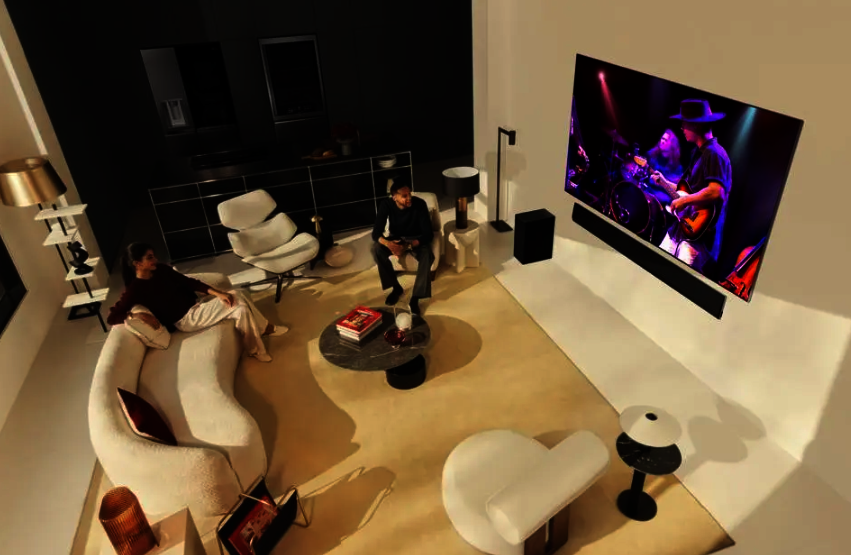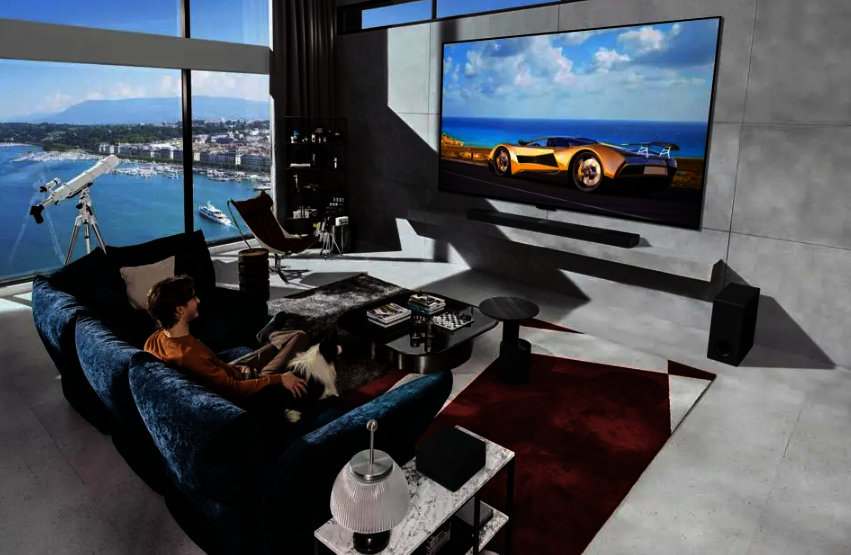There’s less than a week to go until CES 2024 kicks off, but fans of LG Electronics won’t even have to wait that long to see what’s in store for its latest OLED televisions.

The company has just announced its full lineup of OLED TV models for 2024, and all of the usual suspects return, with the all-new LG B4, C4, G4 and M4 (pictured) boasting some nice picture and audio enhancements, as well as fresh AI features. The biggest surprise, perhaps, is that the LG C4 and G4 TVs are now further apart than ever before, and that could cause more headaches for buyers.
The LG M4 and G4 Flagship Models
The flagship models are the LG “Signature” M4 and “Gallery” G4 OLED TVs, and just as with last year’s M3 and G3, they share a lot of the same features in terms of their display panels and internal specifications. For instance, the two TVs both feature LG Display’s most advanced OLED panel with Micro Lens Array technology, which has been rebranded as “Light Control Architecture”.
According to LG’s press release, the M4 and G4 are 70% brighter than TVs fitted with standard OLED TV panels, such as the new LG B4. They also incorporate a new technology known as Peak Highlighter, which helps to boost the brightness of small highlights. With this, the M4 and G4 can achieve 150% higher brightness than the B4 in a small 3% window, LG says, though the company didn’t provide any specific figures comparing the new TVs against last year’s predecessors, the M3 and G3. It did, however, say that brightness is “measurably” superior.
In terms of size options available, the M4 will come in a new 65-inch size option, together with the 77-, 83- and 97-inch options that were available last year. The LG G4 retains the same size options, including 55-, 65-, 77- and 83-inch models. The main difference between the two models is that the M4 features a Zero Connect Box that houses most of the internal components and connections, including three HDMI 2.1 ports. From this box, all of the picture and audio data is transmitted wirelessly to the TV, meaning those ugly cables can be hidden away out of sight.
LG said the M4 supports wireless Dolby Vision, and for the first time it boosts the refresh rate of the new 4K panel to 144Hz. However, gamers should note that the Xbox and PlayStation 5 will only output 120Hz signals, meaning that only PC users will see the benefit of this.
As for the LG G4, this is more standard, with traditional HDMI and USB ports found on the back. The advantage is it has four HDMI 2.1 ports rather than three, with each one capable of 4K/144Hz. One of the ports also supports eARC audio for superior surround sound quality. As with last year’s G3, the G4 is designed to be wall mounted, meaning it doesn’t come with a TV stand.
That’s where the differences end, as the LG M4 and G4 both come with the company’s latest Alpha 11 AI Processor. The new chipset is exclusive to these two models, which is a notable departure from LG’s earlier practice of also integrating its most powerful processor with the C-series OLED TVs. The benefits of the Alpha 11 AI chip include a 70% increase in graphics processing capabilities and a 30% boost in terms of general processing.

In addition, the LG AI Picture Pro technology gets new functionality in the shape of AI Director Processing, which works by detecting the intended colour tone of the content creator and switching to the most appropriate picture mode to reflect that choice. Meanwhile, the new Object Enhancing by Visual Perception technology is able to analyze and enhance each individual pixel on a frame-by-frame basis, helping to create more realistic pictures than ever before. In terms of audio, LG said its AI Sound Pro tech has been enhanced to deliver “richer and fuller” sound quality through the M4’s and G4’s virtual 11.1.2 channel surround sound syste
The LG C4
What’s interesting about this year’s LG TV lineup is that the step-down C-series model lacks the new Alpha 11 AI chip. Previously, LG has always used its most powerful processor in this model, as well as the G-series, so the decision to omit the new chip may concern those who have always preferred the C-series because it’s available in smaller sizes and comes with a TV stand.
LG said the C4 comes with a 144Hz refresh rate like the M4 and G4, and the same panel. It features four HDMI 2.1 ports, like the G4, and it comes in a broader range of sizes, with 42- and 48-inch options as well as 55-, 65-, 77- and 83-inch versions. According to LG, each version will be brighter than last year’s equivalent, though the company didn’t provide any specifics. What it did say is that while the smaller 42- and 48-inch models will be less bright than the larger ones, as with last year’s C3, the difference is much less noticeable now.
However, buyers may be concerned that the C4 is only equipped with last year’s Alpha 9 chip, which means it lacks the new features, such as AI Director Processing and Object Enhancing by Visual Perception tech seen on the M4 and G4.
It used to be that the G-series and C-series OLED TVs only really differed in terms of their sound capabilities and their design. However, in 2022 LG set about changing that by making the G2 OLED TV slightly brighter, and it widened that gap in 2023, when the G3 received an MLA panel but the C3 did not. By not including its latest chipset in the C3, LG has increased the disparity between the two models even further, and that may upset anyone who wants the latest technology but doesn’t want the hassle of mounting the TV onto a wall.
The LG B4
Last but not least in LG’s new range is the LG B4 OLED TV, but despite being a step down model it is once again a compelling alternative to those on a smaller budget.
For one thing, the B4 becomes the first B-series model to come equipped with four HDMI 2.1 connections. That compares to just two HDMI 2.1 ports on last year’s B3.
In addition, the B4 comes with a more advanced processor, the Alpha 8 AI chip, which is just below the Alpha 9 silicon that sits at the heart of the C4. Given that it’s an older chipset, it will likely not support some of the most advanced AI features, though it is still an improvement on last year’s Alpha 7 chipset. We’ll have to wait until next week for more details, as LG didn’t reveal any of the B4’s specific AI-powered functionalities.
Finally, LG said the B4 model will be available in a smaller 48-inch size option, in addition to the traditional 55-, 65- and 77-inch options. This is likely to be good news for those who want a smaller but still very capable OLED TV that doesn’t break the bank.
There are still many details about LG’s new 2024 OLED TV lineup to be revealed, and journalists will have to wait until next week before they can set their eyes upon them when they’re fully unveiled at CES. At that time, we’ll be able to see for ourselves just how impressive the new features, functionality and chipsets really are.
There’s no word yet on pricing or availability. The costs may be a concern given that the economy is still going badly, and LG notably raised its prices for last year’s models. But it remains to be see if the company will do the same thing this time around.
While LG only announced its 2024 OLED TV models today, HDTVTest was among the first to report on the M4's and G4's enhanced refresh rates last week: